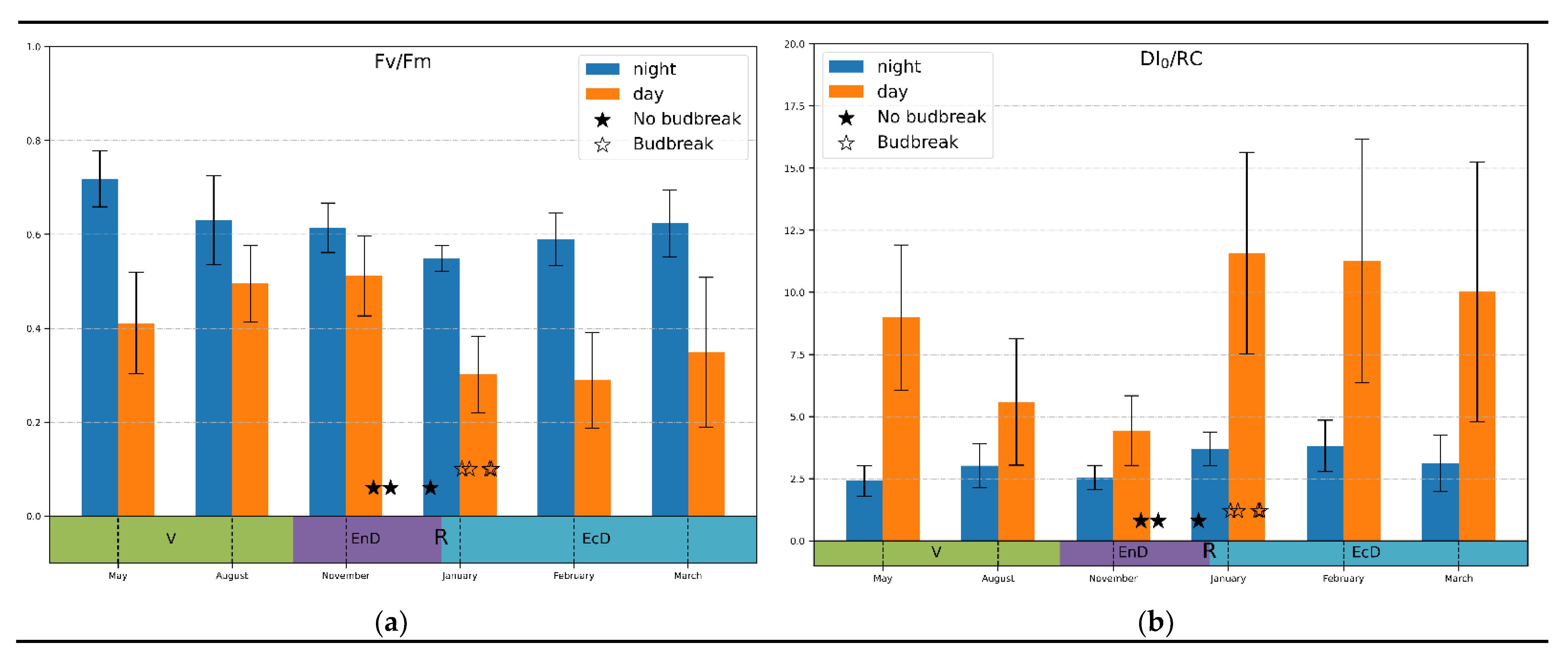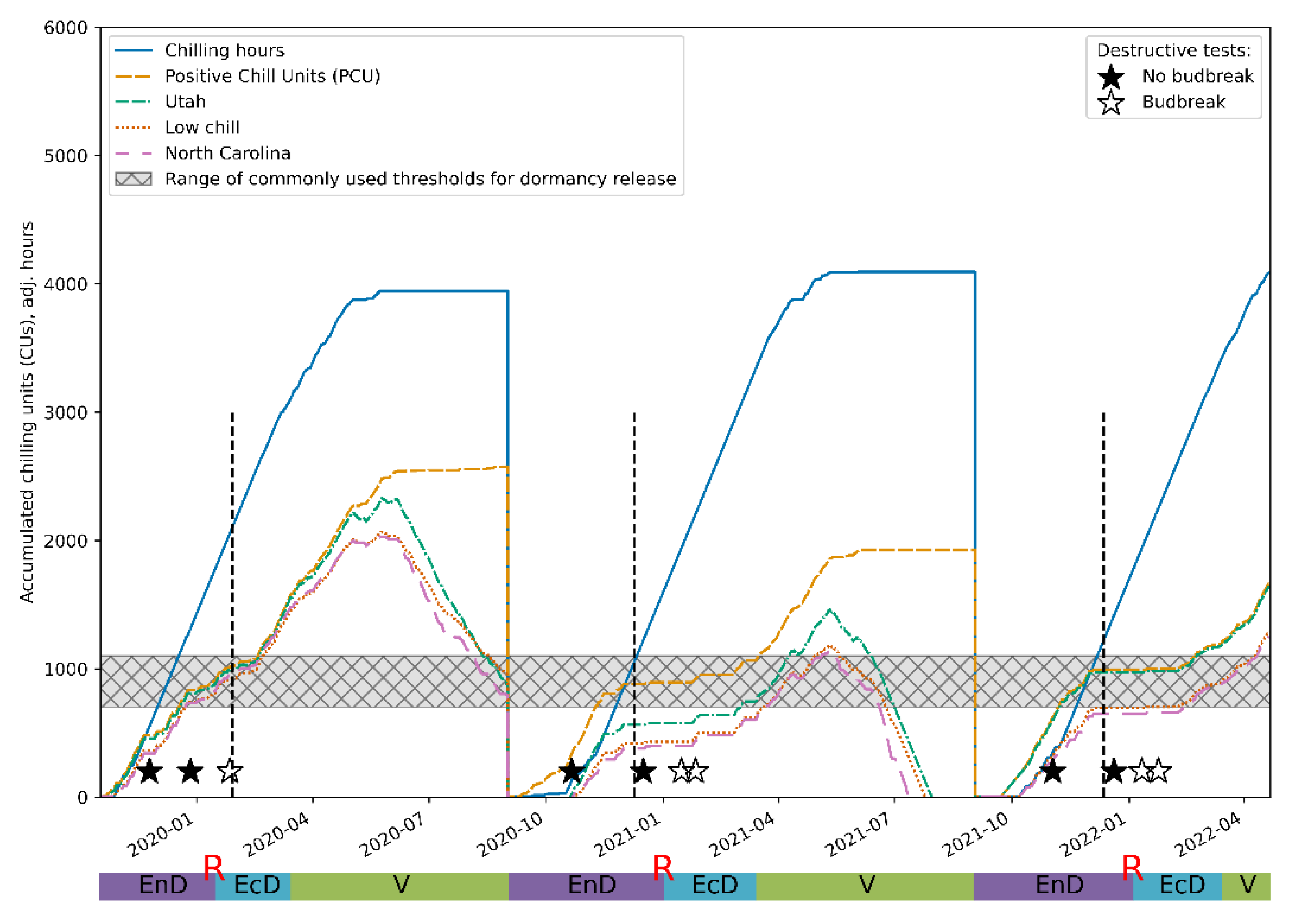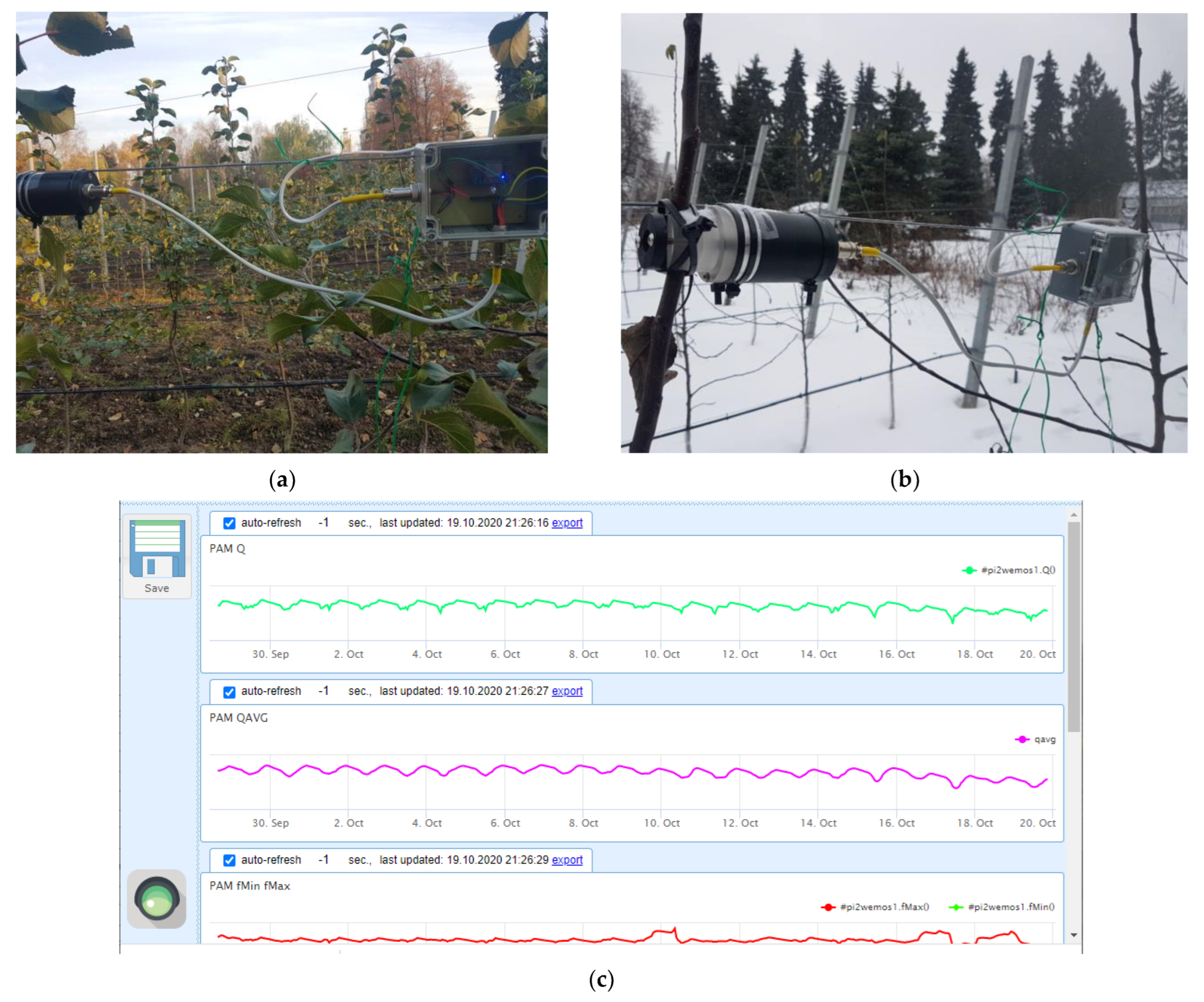Non-Invasive Probing of Winter Dormancy via Time-Frequency Analysis of Induced Chlorophyll Fluorescence in Deciduous Plants as Exemplified by Apple (Malus × domestica Borkh.)
Abstract
:1. Introduction
2. Results and Discussion
2.1. Winter Dormancy and Dormancy Release
2.2. Chlorophyll Fluorescence Transients
2.3. Long-Term Correlations of the CF Parameters and Weather Conditions
2.4. Time-Frequency Analysis of the CF Data
2.5. Agreement of the Non-Invasive Dormancy Assessments with Those Derived from the Common CR Mathematical Models
3. Materials and Methods
3.1. Plant Material and Experiment Design
3.2. Chlorophyll Fluorescence and Weather Data Collection
3.3. Analysis of Fluorescence Transients (JIP Test)
3.4. Data Processing and Analysis
4. Concluding Remarks
Supplementary Materials
Author Contributions
Funding
Data Availability Statement
Acknowledgments
Conflicts of Interest
References
- Withers, P.; Cooper, C. Dormancy. In Encyclopedia of Ecology; Fath, B.D., Ed.; Elsevier: Amsterdam, The Netherlands, 2018; Volume 3, pp. 309–314. [Google Scholar]
- Allona, I.; Ramos, A.; Ibáñez, C.; Contreras, A.; Casado, R.; Aragoncillo, C. Molecular control of winter dormancy establishment in trees: A review. Span. J. Agric. Res. 2008, 6, 201. [Google Scholar] [CrossRef] [Green Version]
- Arora, R.; Rowland, L.J.; Tanino, K. Induction and Release of Bud Dormancy in Woody Perennials: A Science Comes of Age. HortScience 2003, 38, 911–921. [Google Scholar] [CrossRef] [Green Version]
- Yu, J.; Conrad, A.O.; Decroocq, V.; Zhebentyayeva, T.; Williams, D.E.; Bennett, D.; Roch, G.; Audergon, J.-M.; Dardick, C.; Liu, Z.; et al. Distinctive Gene Expression Patterns Define Endodormancy to Ecodormancy Transition in Apricot and Peach. Front. Plant Sci. 2020, 11, 180. [Google Scholar] [CrossRef] [Green Version]
- Considine, M.J.; Considine, J.A. On the language and physiology of dormancy and quiescence in plants. J. Exp. Bot. 2016, 67, 3189–3203. [Google Scholar] [CrossRef] [PubMed] [Green Version]
- Rohde, A.; Bhalerao, R.P. Plant dormancy in the perennial context. Trends Plant Sci. 2007, 12, 217–223. [Google Scholar] [CrossRef]
- Campoy, J.; Ruiz, D.; Egea, J. Dormancy in temperate fruit trees in a global warming context: A review. Sci. Hortic. 2011, 130, 357–372. [Google Scholar] [CrossRef]
- Luedeling, E. Climate change impacts on winter chill for temperate fruit and nut production: A review. Sci. Hortic. 2012, 144, 218–229. [Google Scholar] [CrossRef] [Green Version]
- Yamane, H.; Wada, M.; Honda, C.; Matsuura, T.; Ikeda, Y.; Hirayama, T.; Osako, Y.; Gao-Takai, M.; Kojima, M.; Sakakibara, H.; et al. Overexpression of Prunus DAM6 inhibits growth, represses bud break competency of dormant buds and delays bud outgrowth in apple plants. PLoS ONE 2019, 14, e0214788. [Google Scholar] [CrossRef] [Green Version]
- Maurya, J.P.; Bhalerao, R.P. Photoperiod- and temperature-mediated control of growth cessation and dormancy in trees: A molecular perspective. Ann. Bot. 2017, 120, 351–360. [Google Scholar] [CrossRef] [Green Version]
- Moser, M.; Asquini, E.; Miolli, G.V.; Weigl, K.; Hanke, M.-V.; Flachowsky, H.; Si-Ammour, A. The MADS-Box Gene MdDAM1 Controls Growth Cessation and Bud Dormancy in Apple. Front. Plant Sci. 2020, 11, 1003. [Google Scholar] [CrossRef]
- Heide, O.M. Interaction of photoperiod and temperature in the control of growth and dormancy of Prunus species. Sci. Hortic. 2008, 115, 309–314. [Google Scholar] [CrossRef]
- Cattani, A.M.; Sartor, T.; da Silveira Falavigna, V.; Porto, D.D.; Silveira, C.P.; de Oliveira, P.R.D.; Revers, L.F. The Control of Bud Break and Flowering Time in Plants: Contribution of Epigenetic Mechanisms and Consequences in Agriculture and Breeding. In Advances in Botanical Research; Elsevier: Amsterdam, The Netherlands, 2018; Volume 88, pp. 277–325. [Google Scholar]
- Porto, D.D.; Bruneau, M.; Perini, P.; Anzanello, R.; Renou, J.-P.; dos Santos, H.P.; Fialho, F.B.; Revers, L.F. Transcription profiling of the chilling requirement for bud break in apples: A putative role for FLC-like genes. J. Exp. Bot. 2015, 66, 2659–2672. [Google Scholar] [CrossRef] [PubMed] [Green Version]
- Luedeling, E.; Brown, P.H. A global analysis of the comparability of winter chill models for fruit and nut trees. Int. J. Biometeorol. 2011, 55, 411–421. [Google Scholar] [CrossRef] [PubMed] [Green Version]
- Li, Y.; Wang, L.; Zhu, G.; Fang, W.; Cao, K.; Chen, C.; Wang, X.; Wang, X. Phenological response of peach to climate change exhibits a relatively dramatic trend in China, 1983–2012. Sci. Hortic. 2016, 209, 192–200. [Google Scholar] [CrossRef]
- Vanalli, C.; Casagrandi, R.; Gatto, M.; Bevacqua, D. Shifts in the thermal niche of fruit trees under climate change: The case of peach cultivation in France. Agric. For. Meteorol. 2021, 300, 108327. [Google Scholar] [CrossRef]
- WAPA. European Apple and Pear Crop Forecast; World Apple and Pear Organisation: Brussels, Belgium, 2018.
- Ruiz, D.; Egea, J.; Salazar, J.A.; Campoy, J.A. Chilling and heat requirements of Japanese plum cultivars for flowering. Sci. Hortic. 2018, 242, 164–169. [Google Scholar] [CrossRef]
- Rai, R.; Joshi, S.; Roy, S.; Singh, O.; Samir, M.; Chandra, A. Implications of changing climate on productivity of temperate fruit crops with special reference to apple. J. Hortic. 2015, 2, 135–141. [Google Scholar]
- Fraga, H.; Santos, J.A. Assessment of Climate Change Impacts on Chilling and Forcing for the Main Fresh Fruit Regions in Portugal. Front. Plant Sci. 2021, 12, 1263. [Google Scholar] [CrossRef]
- Salama, A.-M.; Ezzat, A.; El-Ramady, H.; Alam-Eldein, S.; Okba, S.; Elmenofy, H.; Hassan, I.; Illés, A.; Holb, I. Temperate Fruit Trees under Climate Change: Challenges for Dormancy and Chilling Requirements in Warm Winter Regions. Horticulturae 2021, 7, 86. [Google Scholar] [CrossRef]
- Lakso, A. Apple. In Handbook of Environmental Physiology of Fruit Crops: Volume I: Temperate Crop, 1st ed.; Schaffer, B., Andersen, P., Eds.; CRC Press: Boca Raton, FL, USA, 1994; p. 21. [Google Scholar]
- Luedeling, E.; Gebauer, J.; Buerkert, A. Climate change effects on winter chill for tree crops with chilling requirements on the Arabian Peninsula. Clim. Change 2009, 96, 219–237. [Google Scholar] [CrossRef] [Green Version]
- Erez, A. Bud Dormancy; Phenomenon, Problems and Solutions in the Tropics and Subtropics. In Temperate Fruit Crops in Warm Climates; Springer: Berlin/Heidelberg, Germany, 2000; pp. 17–48. [Google Scholar] [CrossRef]
- Zhang, H.-S.; Li, D.-M.; Tan, Q.-P.; Gao, H.-Y.; Gao, D.-S. Photosynthetic activities, C 3 and C 4 indicative enzymes and the role of photoperiod in dormancy induction in ‘Chunjie’peach. Photosynthetica 2015, 53, 269–278. [Google Scholar] [CrossRef]
- Demidchik, V.V.; Shashko, A.Y.; Bandarenka, U.Y.; Smolikova, G.N.; Przhevalskaya, D.A.; Charnysh, M.A.; Pozhvanov, G.A.; Barkosvkyi, A.V.; Smolich, I.I.; Sokolik, A.I.; et al. Plant Phenomics: Fundamental Bases, Software and Hardware Platforms, and Machine Learning. Russ. J. Plant Physiol. 2020, 67, 397–412. [Google Scholar] [CrossRef]
- McAusland, L.; Atkinson, J.A.; Lawson, T.; Murchie, E.H. High throughput procedure utilising chlorophyll fluorescence imaging to phenotype dynamic photosynthesis and photoprotection in leaves under controlled gaseous conditions. Plant Methods 2019, 15, 109. [Google Scholar] [CrossRef] [PubMed]
- Watt, M.; Fiorani, F.; Usadel, B.; Rascher, U.; Muller, O.; Schurr, U. Phenotyping: New Windows into the Plant for Breeders. Annu. Rev. Plant Biol. 2020, 71, 689–712. [Google Scholar] [CrossRef]
- Valcke, R. Can chlorophyll fluorescence imaging make the invisible visible? Photosynthetica 2021, 59, 381–398. [Google Scholar] [CrossRef]
- Pérez-Bueno, M.L.; Pineda, M.; Barón, M. Phenotyping Plant Responses to Biotic Stress by Chlorophyll Fluorescence Imaging. Front. Plant Sci. 2019, 10, 1135. [Google Scholar] [CrossRef]
- Keller, B.; Matsubara, S.; Rascher, U.; Pieruschka, R.; Steier, A.; Kraska, T.; Muller, O. Genotype Specific Photosynthesis x Environment Interactions Captured by Automated Fluorescence Canopy Scans Over Two Fluctuating Growing Seasons. Front. Plant Sci. 2019, 10, 1482. [Google Scholar] [CrossRef] [Green Version]
- Perks, M.P.; Monaghan, S.; O’Reilly, C.; Osborne, B.A.; Mitchell, D.T. Chlorophyll fluorescence characteristics, performance and survival of freshly lifted and cold stored Douglas fir seedlings. Ann. For. Sci. 2001, 58, 225–235. [Google Scholar] [CrossRef] [Green Version]
- Hawkins, C.D.B.; Lister, G.R. Invivo chlorophyll fluorescence as a possible indicator of the dormancy stage in Douglas-fir seedlings. Can. J. For. Res. 1985, 15, 607–612. [Google Scholar] [CrossRef]
- Alekseev, A.A.; Matorin, D.N.; Osipov, V.A.; Venediktov, P.S. Investigation of the photosynthetic activity of bark phelloderm of arboreous plants using the fluorescent method. Mosc. Univ. Biol. Sci. Bull. 2007, 62, 164–170. [Google Scholar] [CrossRef]
- Tikhonov, K.G.; Khristin, M.S.; Klimov, V.V.; Sundireva, M.A.; Kreslavski, V.D.; Sidorov, R.; Tsidendambayev, V.D.; Savchenko, T.V. Structural and functional characteristics of photosynthetic apparatus of chlorophyll-containing grape vine tissue. Russ. J. Plant Physiol. 2017, 64, 73–82. [Google Scholar] [CrossRef]
- Wilson, B.C.; Jacobs, D.F. Chlorophyll fluorescence of stem cambial tissue reflects dormancy development in Juglans nigra seedlings. New For. 2012, 43, 771–778. [Google Scholar] [CrossRef]
- Damesin, C. Respiration and photosynthesis characteristics of current-year stems of Fagus sylvatica: From the seasonal pattern to an annual balance. New Phytol. 2003, 158, 465–475. [Google Scholar] [CrossRef] [PubMed] [Green Version]
- Lennartsson, M.; Ögren, E. Predicting the cold hardiness of willow stems using visible and near-infrared spectra and sugar concentrations. Trees 2003, 17, 463–470. [Google Scholar] [CrossRef]
- Oquist, G.; Brunes, L.; Hallgren, J.-E.; Gezelius, K.; Hallen, M.; Malmberg, G. Effects of artificial frost hardening and winter stress on net photosynthesis, photosynthetic electron transport and RuBP carboxylase activity in seedlings of Pinus silvestris. Physiol. Plant. 1980, 48, 526–531. [Google Scholar] [CrossRef]
- Grebe, S.; Trotta, A.; Bajwa, A.A.; Suorsa, M.; Gollan, P.J.; Jansson, S.; Tikkanen, M.; Aro, E.M. The unique photosynthetic apparatus of Pinaceae—Analysis of photosynthetic complexes in Norway spruce (Piceaabies). J. Exp. Bot. 2019, 70, 3211–3225. [Google Scholar] [CrossRef] [Green Version]
- Grebe, S.; Trotta, A.; Bajwa, A.A.; Mancini, I.; Bag, P.; Jansson, S.; Tikkanen, M.; Aro, E.-M. Specific thylakoid protein phosphorylations are prerequisites for overwintering of Norway spruce (Picea abies) photosynthesis. Proc. Natl. Acad. Sci. USA 2020, 117, 17499–17509. [Google Scholar] [CrossRef]
- Ivanov, A.; Sane, P.; Zeinalov, Y.; Simidjiev, I.; Huner, N.; Öquist, G. Seasonal responses of photosynthetic electron transport in Scots pine (Pinus sylvestris L.) studied by thermoluminescence. Planta 2002, 215, 457–465. [Google Scholar]
- Kalaji, H.M.; Schansker, G.; Brestic, M.; Bussotti, F.; Calatayud, A.; Ferroni, L.; Goltsev, V.; Guidi, L.; Jajoo, A.; Li, P.; et al. Frequently asked questions about chlorophyll fluorescence, the sequel. Photosynth. Res. 2017, 132, 13–66. [Google Scholar] [CrossRef] [Green Version]
- Goltsev, V.N.; Kalaji, H.M.; Paunov, M.; Bąba, W.; Horaczek, T.; Mojski, J.; Kociel, H.; Allakhverdiev, S.I. Variable chlorophyll fluorescence and its use for assessing physiological condition of plant photosynthetic apparatus. Russ. J. Plant Physiol. 2016, 63, 869–893. [Google Scholar] [CrossRef]
- Stirbet, A.; Riznichenko, G.Y.; Rubin, A.B. Govindjee Modeling chlorophyll a fluorescence transient: Relation to photosynthesis. Biochem. Mosc. 2014, 79, 291–323. [Google Scholar] [CrossRef] [PubMed]
- Maxwell, K.; Johnson, G. Chlorophyll fluorescence-a practical guide. J. Exp. Bot. 2000, 51, 659–668. [Google Scholar] [CrossRef] [PubMed]
- Strasser, R.; Tsimilli-Michael, M.; Srivastava, A. Analysis of the chlorophyll a fluorescence transient. In Chlorophyll a Fluorescence: A Signature of Photosynthesis; Papageorgiou, G.C., Ed.; Springer: Berlin/Heidelberg, Germany, 2004; pp. 321–362. [Google Scholar]
- Linkosalo, T.; Heikkinen, J.; Pulkkinen, P.; Mäkipää, R. Fluorescence measurements show stronger cold inhibition of photosynthetic light reactions in Scots pine compared to Norway spruce as well as during spring compared to autumn. Front. Plant Sci. 2014, 5, 264. [Google Scholar] [CrossRef] [PubMed] [Green Version]
- Sundblad, L.-G.; Sjöström, M.; Malmberg, G.; Öquist, G. Prediction of frost hardiness in seedlings of Scots pine (Pinus sylvestris) using multivariate analysis of chlorophyll a fluorescence and luminescence kinetics. Can. J. For. Res. 1990, 20, 592–597. [Google Scholar] [CrossRef]
- Sakar, E.H.; El Yamani, M.; Rharrabti, Y. Frost susceptibility of five almond [Prunus dulcis (mill.) DA Webb] cultivars grown in north-eastern Morocco as revealed by chlorophyll fluorescence. Int. J. Fruit Sci. 2017, 17, 415–422. [Google Scholar] [CrossRef]
- Savitch, L.V.; Leonardos, E.D.; Krol, M.; Jansson, S.; Grodzinski, B.; Huner, N.P.A.; Öquist, G. Two different strategies for light utilization in photosynthesis in relation to growth and cold acclimation. Plant Cell Environ. 2002, 25, 761–771. [Google Scholar] [CrossRef]
- Corcuera, L.; Gil-Pelegrín, E.; Notivol, E. Intraspecific Variation in Pinus Pinaster PSII Photochemical Efficiency in Response to Winter Stress and Freezing Temperatures. PLoS ONE 2011, 6, e28772. [Google Scholar] [CrossRef] [Green Version]
- Chang, C.Y.; Bräutigam, K.; Hüner, N.P.A.; Ensminger, I. Champions of winter survival: Cold acclimation and molecular regulation of cold hardiness in evergreen conifers. New Phytol. 2021, 229, 675–691. [Google Scholar] [CrossRef]
- Heide, O.M.; Prestrud, A.K. Low temperature, but not photoperiod, controls growth cessation and dormancy induction and release in apple and pear. Tree Physiol. 2005, 25, 109–114. [Google Scholar] [CrossRef] [Green Version]
- Weinberger, J.H. Chilling requirements of peach varieties. In Proceedings of the American Society for Horticultural Science; American Society for Horticultural Science: Alexandria, VA, USA, 1950; pp. 122–128. [Google Scholar]
- Richardson, E.; Seeley, S.; Walker, D. A model for estimating the completion of rest for “Redhaven” and “Elberta” peach trees. Hortscience 1974, 9, 331–332. [Google Scholar] [CrossRef]
- Gilreath, P.; Buchanan, D. Rest prediction model for low-chilling “Sungold” nectarine. J. Am. Soc. Hortic. Sci. 1981, 106, 426–429. [Google Scholar] [CrossRef]
- Shaltout, A.D.; Unrath, C. Rest Completion Prediction Model for ‘Starkrimson Delicious’ Apples. J. Am. Soc. Hortic. Sci. 1983, 108, 957–961. [Google Scholar] [CrossRef]
- Kolber, Z.S.; Prášil, O.; Falkowski, P.G. Measurements of variable chlorophyll fluorescence using fast repetition rate techniques: Defining methodology and experimental protocols. Biochim. Biophys. Acta 1998, 1367, 88–106. [Google Scholar] [CrossRef] [Green Version]
- Antal, T.; Konyukhov, I.; Volgusheva, A.; Plyusnina, T.; Khruschev, S.; Kukarskikh, G.; Goryachev, S.; Rubin, A. Chlorophyll fluorescence induction and relaxation system for the continuous monitoring of photosynthetic capacity in photobioreactors. Physiol. Plant. 2019, 165, 476–486. [Google Scholar] [CrossRef] [PubMed]
- Plyusnina, T.; Khruschev, S.; Degtereva, N.; Konyukhov, I.; Solovchenko, A.; Kouzmanova, M.; Goltsev, V.; Riznichenko, G.; Rubin, A. Special issue in honour of Prof. Reto J. Strasser—Gradual changes in the photosynthetic apparatus triggered by nitrogen depletion during microalgae cultivation in photobioreactor. Photosynthetica 2020, 58, 443–451. [Google Scholar] [CrossRef] [Green Version]
- Plyusnina, T.Y.; Khruschev, S.; Riznichenko, G.; Rubin, A.B. An analysis of the chlorophyll fluorescence transient by spectral multi-exponential approximation. Biophysics 2015, 60, 392–399. [Google Scholar] [CrossRef]
- Folkner, W.M.; Williams, J.G.; Boggs, D.H.; Park, R.S.; Kuchynka, P. The Planetary and Lunar Ephemerides DE430 and DE431. Interplanet. Netw. Prog. Rep. 2014, 196, 42–196. [Google Scholar] [CrossRef]
- Meinel, A.B.; Meinel, M.P. Applied solar energy: An introduction. NASA STI/Recon Tech. Rep. A 1977, 77, 33445. [Google Scholar] [CrossRef]
- Hüner, N.P.; Dahal, K.; Hollis, L.; Bode, R.; Rosso, D.; Krol, M.; Ivanov, A.G. Chloroplast redox imbalance governs phenotypic plasticity: The “grand design of photosynthesis” revisited. Front. Plant Sci. 2012, 3, 255. [Google Scholar] [CrossRef] [Green Version]
- Huner, N.P.; Öquist, G.; Sarhan, F. Energy balance and acclimation to light and cold. Trends Plant Sci. 1998, 3, 224–230. [Google Scholar] [CrossRef]
- Nedbal, L.; Lazár, D. Photosynthesis dynamics and regulation sensed in the frequency domain. Plant Physiol. 2021, 187, 646–661. [Google Scholar] [CrossRef] [PubMed]
- Heisenberg, W. Über den anschaulichen Inhalt der quantentheoretischen Kinematik und Mechanik. Eur. Phys. J. A 1927, 43, 172–198. [Google Scholar] [CrossRef]
- Gabor, D. Theory of communication. J. Inst. Electr. Eng. 1946, 93, 429–441. [Google Scholar] [CrossRef]
- Boashash, B. Time-Frequency Signal Analysis and Processing: A Comprehensive Reference; Academic Press: London, UK, 2016; pp. 1–49. [Google Scholar]
- Tan, L.; Jiang, J. Image filtering enhancement. In Digital Signal Processing: Fundamentals and Applications, 3rd ed.; Merken, S., Ed.; Academic Press: London, UK, 2018; pp. 673–683. [Google Scholar]










| Sampling Time | % of Shoots Displaying Budbreak 1 | ||
|---|---|---|---|
| 2019 | 2020 | 2021 | |
| November | 0 | 0 | 0 |
| December | 0 | 10±5 | 7 ± 4 |
| January | 65 ± 15 2 | 85 ± 6 | 92 ± 6 |
| February | 75 ± 4 | 96 ± 3 | 98 ± 3 |
Publisher’s Note: MDPI stays neutral with regard to jurisdictional claims in published maps and institutional affiliations. |
© 2022 by the authors. Licensee MDPI, Basel, Switzerland. This article is an open access article distributed under the terms and conditions of the Creative Commons Attribution (CC BY) license (https://creativecommons.org/licenses/by/4.0/).
Share and Cite
Shurygin, B.; Konyukhov, I.; Khruschev, S.; Solovchenko, A. Non-Invasive Probing of Winter Dormancy via Time-Frequency Analysis of Induced Chlorophyll Fluorescence in Deciduous Plants as Exemplified by Apple (Malus × domestica Borkh.). Plants 2022, 11, 2811. https://doi.org/10.3390/plants11212811
Shurygin B, Konyukhov I, Khruschev S, Solovchenko A. Non-Invasive Probing of Winter Dormancy via Time-Frequency Analysis of Induced Chlorophyll Fluorescence in Deciduous Plants as Exemplified by Apple (Malus × domestica Borkh.). Plants. 2022; 11(21):2811. https://doi.org/10.3390/plants11212811
Chicago/Turabian StyleShurygin, Boris, Ivan Konyukhov, Sergei Khruschev, and Alexei Solovchenko. 2022. "Non-Invasive Probing of Winter Dormancy via Time-Frequency Analysis of Induced Chlorophyll Fluorescence in Deciduous Plants as Exemplified by Apple (Malus × domestica Borkh.)" Plants 11, no. 21: 2811. https://doi.org/10.3390/plants11212811
APA StyleShurygin, B., Konyukhov, I., Khruschev, S., & Solovchenko, A. (2022). Non-Invasive Probing of Winter Dormancy via Time-Frequency Analysis of Induced Chlorophyll Fluorescence in Deciduous Plants as Exemplified by Apple (Malus × domestica Borkh.). Plants, 11(21), 2811. https://doi.org/10.3390/plants11212811






